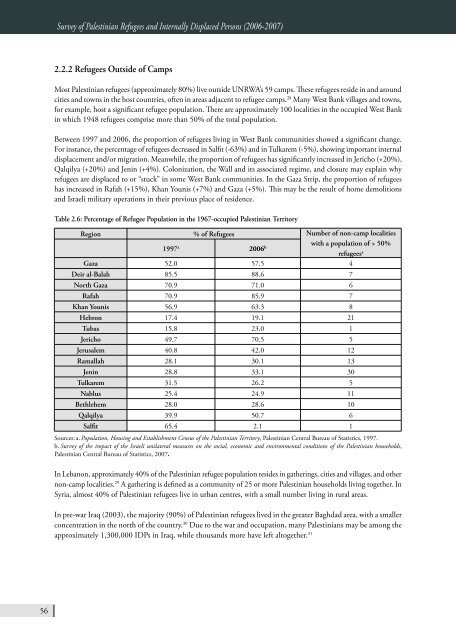BADIL Resource Center for Palestinian Residency and Refugee
BADIL Resource Center for Palestinian Residency and Refugee
BADIL Resource Center for Palestinian Residency and Refugee
Create successful ePaper yourself
Turn your PDF publications into a flip-book with our unique Google optimized e-Paper software.
56<br />
Survey of <strong>Palestinian</strong> <strong>Refugee</strong>s <strong>and</strong> Internally Displaced Persons (2006-2007)<br />
2.2.2 <strong>Refugee</strong>s Outside of Camps<br />
Most <strong>Palestinian</strong> refugees (approximately 80%) live outside UNRWA’s 59 camps. These refugees reside in <strong>and</strong> around<br />
cities <strong>and</strong> towns in the host countries, often in areas adjacent to refugee camps. 28 Many West Bank villages <strong>and</strong> towns,<br />
<strong>for</strong> example, host a significant refugee population. There are approximately 100 localities in the occupied West Bank<br />
in which 1948 refugees comprise more than 50% of the total population.<br />
Between 1997 <strong>and</strong> 2006, the proportion of refugees living in West Bank communities showed a significant change.<br />
For instance, the percentage of refugees decreased in Salfit (-63%) <strong>and</strong> in Tulkarem (-5%), showing important internal<br />
displacement <strong>and</strong>/or migration. Meanwhile, the proportion of refugees has significantly increased in Jericho (+20%),<br />
Qalqilya (+20%) <strong>and</strong> Jenin (+4%). Colonization, the Wall <strong>and</strong> its associated regime, <strong>and</strong> closure may explain why<br />
refugees are displaced to or “stuck” in some West Bank communities. In the Gaza Strip, the proportion of refugees<br />
has increased in Rafah (+15%), Khan Younis (+7%) <strong>and</strong> Gaza (+5%). This may be the result of home demolitions<br />
<strong>and</strong> Israeli military operations in their previous place of residence.<br />
Table 2.6: Percentage of <strong>Refugee</strong> Population in the 1967-occupied <strong>Palestinian</strong> Territory<br />
Region % of <strong>Refugee</strong>s Number of non-camp localities<br />
with a population of > 50%<br />
1997 a 2006 b<br />
refugees a<br />
Gaza 52.0 57.5 4<br />
Deir al-Balah 85.5 88.6 7<br />
North Gaza 70.9 71.0 6<br />
Rafah 70.9 85.9 7<br />
Khan Younis 56.9 63.3 8<br />
Hebron 17.4 19.1 21<br />
Tubas 15.8 23.0 1<br />
Jericho 49.7 70.5 5<br />
Jerusalem 40.8 42.0 12<br />
Ramallah 28.1 30.1 13<br />
Jenin 28.8 33.1 30<br />
Tulkarem 31.5 26.2 5<br />
Nablus 25.4 24.9 11<br />
Bethlehem 28.0 28.6 10<br />
Qalqilya 39.9 50.7 6<br />
Salfit 65.4 2.1 1<br />
Sources: a. Population, Housing <strong>and</strong> Establishment Census of the <strong>Palestinian</strong> Territory, <strong>Palestinian</strong> Central Bureau of Statistics, 1997.<br />
b. Survey of the impact of the Israeli unilateral measures on the social, economic <strong>and</strong> environmental conditions of the <strong>Palestinian</strong> households,<br />
<strong>Palestinian</strong> Central Bureau of Statistics, 2007.<br />
In Lebanon, approximately 40% of the <strong>Palestinian</strong> refugee population resides in gatherings, cities <strong>and</strong> villages, <strong>and</strong> other<br />
non-camp localities. 29 A gathering is defined as a community of 25 or more <strong>Palestinian</strong> households living together. In<br />
Syria, almost 40% of <strong>Palestinian</strong> refugees live in urban centres, with a small number living in rural areas.<br />
In pre-war Iraq (2003), the majority (90%) of <strong>Palestinian</strong> refugees lived in the greater Baghdad area, with a smaller<br />
concentration in the north of the country. 30 Due to the war <strong>and</strong> occupation, many <strong>Palestinian</strong>s may be among the<br />
approximately 1,300,000 IDPs in Iraq, while thous<strong>and</strong>s more have left altogether. 31

















